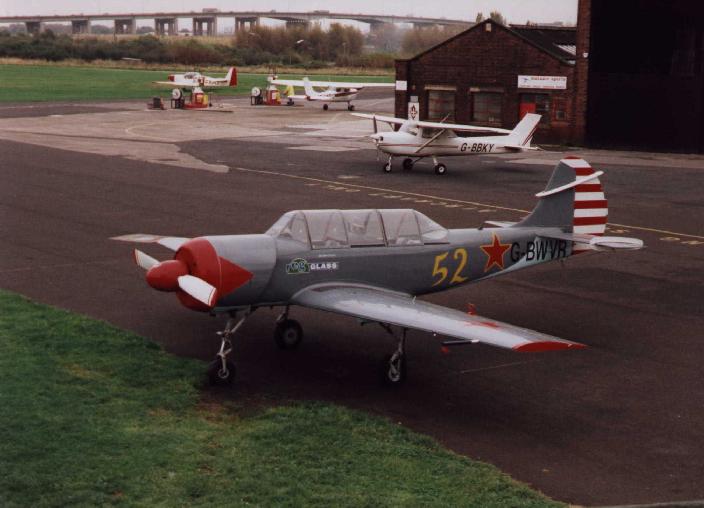
A Yakovlev-52 (Russian primary military trainer). There's quite a few Yaks on the civil registry in the UK. In the background are two C-152's and a Robin, and a big landmark, the Barton Bridge which carries the M60 over the canal.
| -- Flying in the North of England -- |
|---|
Introduction.
This page will cover my experience on my three week trip at which point I finally got to take my mother for a flight (and one of my Dad's friends too). For those of you who haven't actually spoken to me in person... England is my native country. In fact, I was born in Manchester which is where I went flying. I have been on an international assignment with my company for the last 3 years (basically not long after I graduated from University), and therefore learned to fly and have done virtually all my flying based out of Houston Gulf airport in south east Texas. So although England might be my native country, and Manchester might be where I came from, as far as flight training goes, when I go back to England I'm effectively a foreigner since I was "brought up" on an FAA flight training diet. This means flying in England to me is just like it would be for anyone from the U.S... except I don't have the accent. This is a bit of a disadvantage for me because if I make a goof on the radio, I don't get cut any slack because the person on the other end doesn't know I've really done all my flying around Texas! (The other thing is I can't do a Texan accent either to save my life... the only accent I can do an impression of is South African, and I do that badly! The funny thing is that everyone over here is convinced I'm Austrailian which I still can't work out)
Barton Aerodrome.
Barton has quite a rich history. It was originally Manchester's
main airport until they outgrew it. The Lancashire Aero Club (which incidentally
is no longer in Lancashire, since this bit of the world became Greater Manchester
in the early 1970's) has been in existence since the 1920's. I've never heard
of a club or FBO lasting that long. Barton itself is a very busy GA airport.
Most GA airports I've been to are utterly dead at 2:30pm in the middle of
the week. At this time, Barton is humming and the AFISO is busier than a
person trying to herd thirty cats. How the grass runways survive this pounding
I'll never know - probably careful mowing and the main runway (09/27) having
a north and a south section they can switch between when one gets too worn
out... but it's quite bumpy none the less. When I got to Barton during my
vacation this time round, England had just about had the wettest summer on
record and so the grass was in very good condition.
If it's GA and flies, it's probably at Barton. The ramp contained
the usual assortment of Pipers and Cessnas, but mixed in were Robins, Slingsbys,
numerous helicopters and a couple of Yak-52's. There was even a small jet
trainer parked in one corner of the field (don't know whether it was flyable
or not!) and I saw a Shrike Commander depart one day (that's what Bob Hoover
flies) and it had a very short takeoff roll. There were also quite a few
microlights based at Barton both three axis and flexwing (basically ultralights
or two seat ultralights - the regulations are a little different for this
type of aircraft in England).

On my trip, I decided I would fly the Cessna 172 despite it not being the cheapest aircraft I could have flown. This is because I like having the extra power the C-172 offers over the two seat trainers, and the fact that the flight school was not short of planes but short of instructors! With the wet summer that they've had, people were booking weeks in advance and I was lucky to get checked out at all, so I wanted to fly something I was familiar with which had a bit of power. If the demand wasn't so high on the instructors, I would have liked to have been checked out in a Grob 112 since I've never flown one before, and the school had two. The instructor (and CAA examiner), Martin Rushbrooke, who I flew with has a very high opinion of the Grob as a primary trainer as it's not as docile as a Cessna 150/152. Maybe next time! So I got checked out in G-BOIL, a well-equipped C172 (King radio stack with RNAV - very useful when finding a grass airport... and it even sports two altimeters).
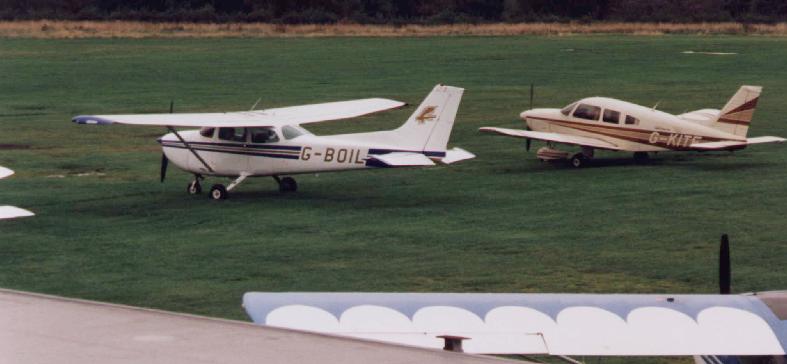
To get checked out, I had to take the first slot I could. I actually went to the LAC flight school office in person to buy CAP 85 and a chart for the area, then book something a couple of days away so I would get a chance to do some homework first. However, it didn't quite work out that way. They didn't have an instructor free for over a week! Plenty of planes, but all the instructors were booked solid. However... they had one slot available in half an hour! Since the weather was sunny but a bit hazy, I said I'd take it rather than risk having bad weather canceling my slot in 10 days time. So I didn't really have the radio work down to pat, but since I already had Trevor Thom's R/T book I could at least make some headway.
Takeoff.
They say if you can fly from Barton you can fly from anywhere.
I keep hearing that story from so many airports (including Houston Gulf,
mainly on account of the windshear you always get on approach to 13, plus
the crosswind), but in the case of Barton, there's more than a grain of truth.
It's bumpy, busy and fairly short with obstacles on the approach paths. However,
crosswinds aren't too much of a problem as there are three runways available
for use (09/27, 02/20, 32/14). We used a standard short field take off flap
setting of 10 degrees. However, contrary to popular concrete runway pilot's
belief, you don't need to hold the nosewheel off the ground on your takeoff
roll - you just need a bit of back pressure to unload the nosewheel so it
doesn't get beaten up by the bumps. Holding the nosewheel clear of the ground
just extends your takeoff roll by increasing induced drag. You only need
to do that if the runway is a quagmire or really rough! Before you are quite
at flying speed, some of the bumps on the runway just nudge you into ground
effect. Then the plane seems to leap off the runway into the nice cool dense
air. With myself, Martin and 3/4ths fuel, we climbed at over 1000 fpm once
settled at Vy. The trees at the end of 09 that looked menacing only seconds
before slid beneath the wheels with room to spare.
It was good to go with an instructor again - it fixed some bad
habits I had picked up like letting go of the throttle to retrim 50 feet
off the ground!
| -- The local area -- |
|---|
Martin showed me around the local area as part of the checkout. The biggest landmark is the TV transmitter on Winter Hill to the north of the airport. Winter Hill rises up quickly from not much above sea level to 1437 feet, and it has a 1015 foot transmitter mast right on top, the top being 2452 feet AMSL. It's a very good landmark. Once we got out of the Barton low-flying area (SFC-1500 ft MSL) which is cut out of Manchester International's airspace, we could climb up to a maximum of 3,500 feet (over which lies Manchester TMA, which is Class A airspace. If you keep going to the north, the class A keeps rising until it no longer gets in the way of general aviation traffic). We used an area around here to do the airwork part of the checkout. This included basic coordination checks (Dutch rolls, medium turns etc), steep turns (60 degrees of bank), stalls and all the other basic checkout items you would expect at a new FBO in the US. We spent an hour in total "brakes off to brakes on" doing the checkout.
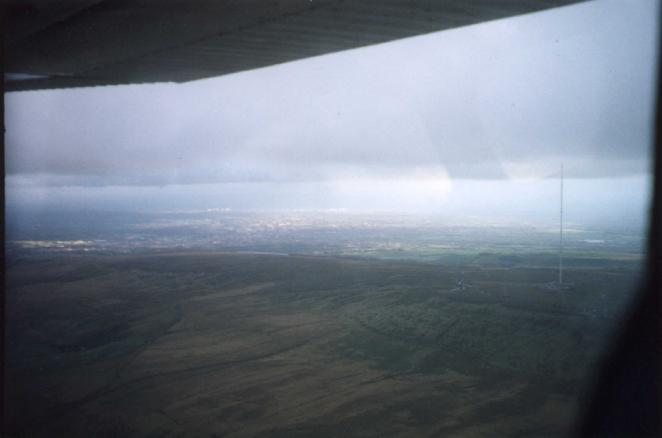
We returned to Barton after the airwork. It's quite hard to
see it (basically look for the field amongst lots of other fields and try
to pick out the one with planes parked on it). However, Martin showed me
a good landmark to use. There is a large wooded area embedded in the farm
fields that curves like a giant longbow. If you imagine yourself to be the
arrow to be shot from the longbow, you will be pointed straight at Barton.
The Barton Bridge is also a helpful landmark. If I got lost I could always
use the RNAV to displace Manchester VOR over Barton.
Airspeed control is important here! We used 55 KIAS with 40
degrees of flap on final since there were no wind gusts. You don't float
much in the flare and you don't want to as it will use up valuable runway.
Making sure the mainwheels touch first and the nose doesn't come down too
fast is imperative, so a small amount of power is useful to keep good elevator
authority. We did three touch and goes, and I was cured of some more bad
habits plus learning new visual references. On a concrete runway, the runway
edges help you judge your height over the runway. These aren't there on grass.
You can't tell the runway from the surrounding field in your peripheral vision.
In fact I'm not sure how I really started judging my height in the flare,
but I had it cracked on my third landing and started making nice landings
on grass. The bad habits I had cured - the first landing, I ballooned a bit
in the flare because I wasn't used to the visual picture, so I let the yoke
out a little. I heard a sharp intake of breath from Martin in the right seat
when I did that! The best thing to do is to imagine the yoke is on a ratchet
and never ever let it go forward - just use a judicious amount of power to
control your sink rate if you ballooned and start to come down a bit fast
(or go round if it got too bad).
| -- Signed off! -- |
|---|
I got signed off and got my 1 month membership of the Lancashire Aero Club. I did one solo practise session before taking anyone with me to ensure I had landing on the short grass runway plus the R/T down good. The session went well, and I made some nice landings so I took both my mum and a friend flying (both of them first time passenger in a light aircraft, and both of them were very good passengers!) Unfortunately, I didn't get the chance to do a cross country. My flight with my Mum was quite memorable - visibility was extremely good because a cold front had passed the night before. It was quite cold and breezy, and it was early evening when I got back...and the wind favored Runway 27. The sun was starting to get lower in the sky when I landed but not quite setting yet...so it was extremely bright and in my face on final approach! It was quite hard to see the runway, but I could see it and kept lined up for a nice landing. In retrospect, it might have been easier to land on 22 and follow the student practising crosswind landings!
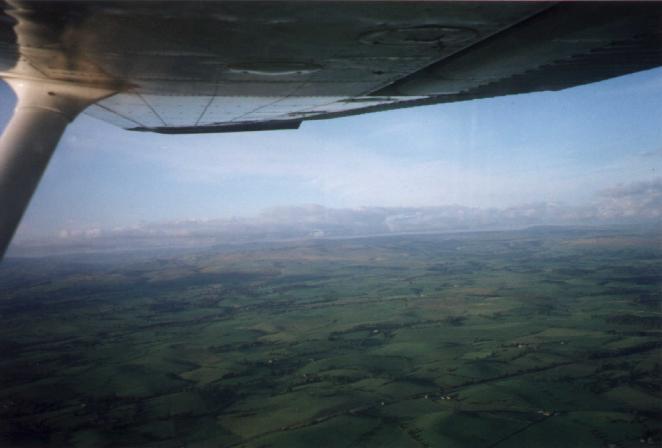
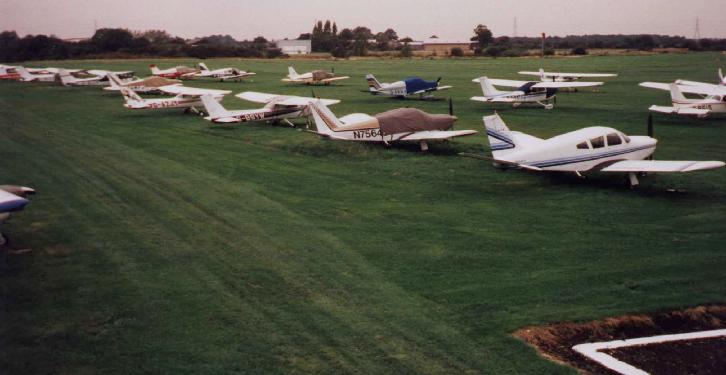
A few of the aircraft tied down outside. There's even an N-numbered aircraft
(probably a recent import).

A small village nestles in the hills.
[Back to Flying in England]
[Back to Flying]
[Home page]